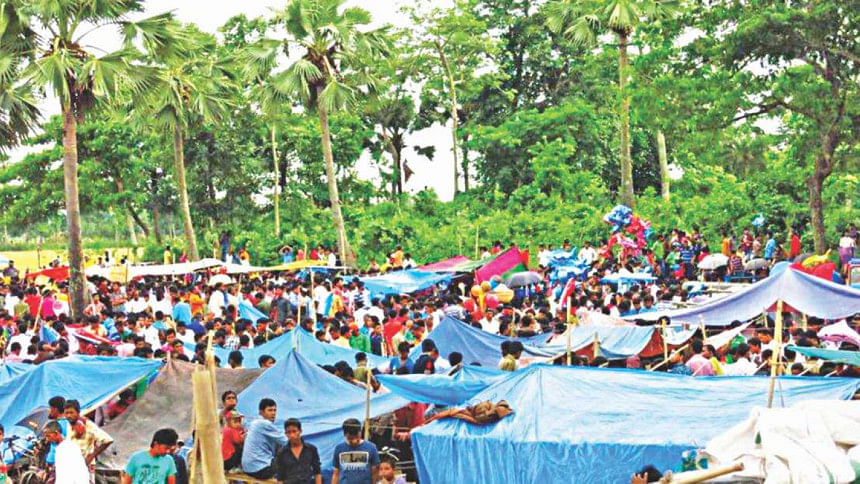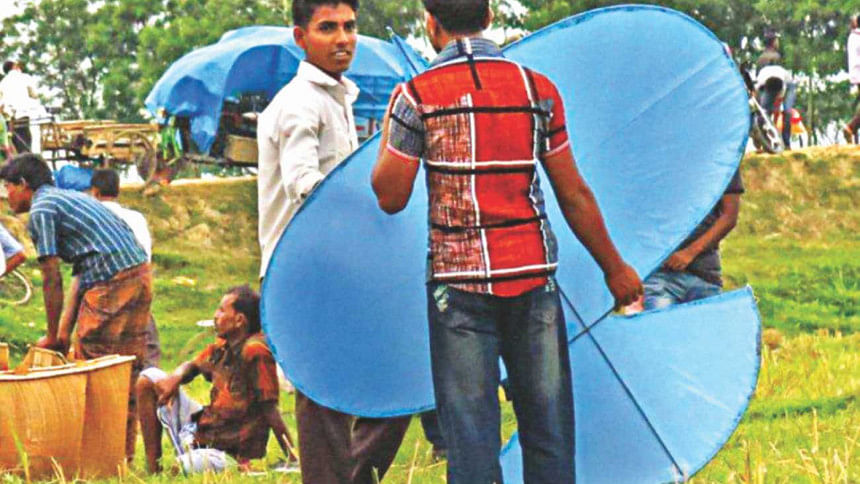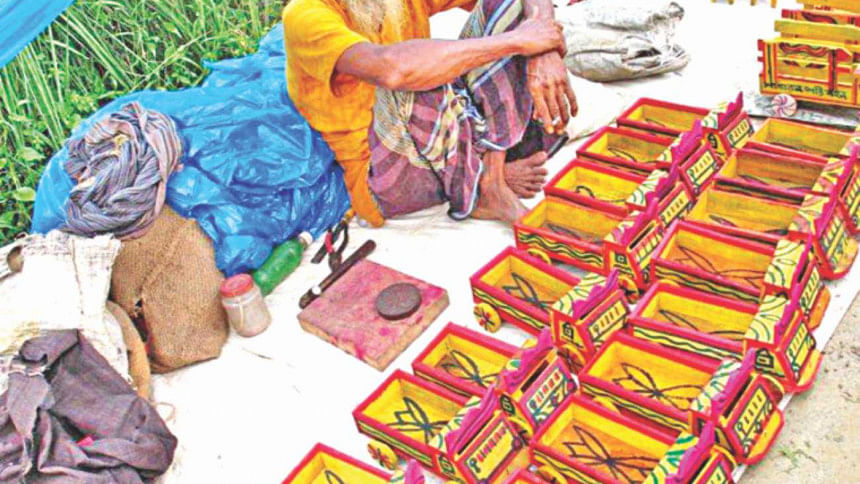My childhood's taal-patar bashi

Once upon a time there used to be 'melas', or local fairs, even in Dhaka. Baishakhi mela, Muharram mela, Eid mela, and Durga Puja mela were just a few of the variety of melas that we use to have.
I still remember—earthen pots, reed and leaf flutes, earthen toys, kites of all types, tomtom, spinning tops, toy cars, balls, balloons, toy utensils, earrings, nose pins, hair clips and ribbons, saris and clothes, cosmetics and soaps, cleavers and stirrers, chotpoti, kotkoti, and even paper lanterns!
As I grew older, going to melas became a rarer activity, and now it seems the tradition of fairs of yore in the city is lost completely. It seems to only exist in the songs of modern bands, like Maksud when he sings "Melay jai re, melay jai re, Bashanti rong sari porey lolonara hetey jae..."
Yet, our rural areas have held onto the tradition of the mela. Melas are intertwined with the culture and heritage of Bengal for decades, if not centuries. When and where the tradition began remains unknown, but there is usually a legend associated with every mela, to somewhat explain its beginning or existence in that particular place and time.

One quite renowned and historic mela of large fish takes place at Poradoho area in Bogra. Legend has it, that once a large katla fish emerged out of the river there with a basket of gold on its back. Of course, people came from far and wide to see such a fish, and along them came one monk, who set up his monastery in the area. This made the place popular with the people of the whole region, and the tradition of the mela, with large fish as its main focus, began. The mela continues to this day.
That is how people would find a reason, usually a festival, to come together and celebrate, which gradually formed into melas over the years. People would bring about their products to sell to these congregating people.
The zamindars, nawabs, kings and the rich merchants all had particular contribution to popularising melas. Also, the followers of the Sanatan Dharm, or Hindus as they are commonly called, also have a rich tradition of melas, particularly surrounding their festivals.
A common saying goes that they have 13 festivals in 12 months! And none of these festivals are complete without a related mela. Like Roth-jatrar mela, Ashwini Pujar mela, Maghi Purnimar mela, Chorok pujar mela, Jhulonjatrar mela, Kartikbroter mela, Rash mela and many more.
In Lalmonirhat in the north, there takes place a bou-shashurir mela, literally the fair of the daughter-in-law and mother-in-law, and Jamalpur, Kishoreganj and Tangail host Jamai mela, or the fair for the son-in-law!
All these are three to four centuries old.
Faridpur hosts the Kobi Jasimuddin mela, in memory of the celebrated poet, and Kushtia hosts Lalon Mela and Shagordari's Modhumela, in memory Michael Madhusudan Dutt.

The Rashmela at Sundarban's Dublar Char is very popular, and people from far and wide go to see it. There are many stories prevalent about the mela in pop culture. Whatever the stories may be, what happened to one of our own friends was not uninteresting either.
The tradition for Hindus is to pray on the beach before the sunrise, and then take a dip in the water of the first high tide to wash away their sins. So this over-enthusiastic friend of ours also went to take a dip, but then got stuck and could not get out of the water.
You see, a dog had though it fit to drag away his clothes from where he kept them on the beach. May be he caught on to the friend as a fake pilgrim!
Years ago, villages would hold Nabanno melas after the rice crop was harvested in late autumn. Some villages still have these. This was traditionally the time people had some money from selling their crops, and hence they would also buy many things from the Nabanno mela.
Many people think that the tradition of the mela is just an extension of the village haat. The haat day in the rural area is quite an enjoyable and fun day for most. Homesteaders and farmers prepare for the day, to sell and buy things.
The whole outlook is somewhat festive, and the villages remain abuzz with festivity, and the modes of transport - horses or carts or even rickshaws - are kept at the ready.
The men in the family go to the haat and the whole house can be seen full of the new things they bring back with them. Some special items are inevitably cooked, enticing with their wafting fragrances. Almost all families set aside some money for the 'all important' haat day.
Just like the land of Bengal, its rivers and its fruits are quintessentially Bengali, so is the culture of mela. It is a cherished Bengali heritage. There is no region in this land where a mela is not organised at least once a year.
Also, you will notice that the mela's venue does not change easily, even over the years. The particular spot by the river bank, under the ancient and shadowy banyan tree, the village school's field, or even the temple yard or village field. Artists bring their songs to melas—bhatiali, jari, shari, kobigan, bhokti-geeti. Circus performers charm visitors, and so do puppeteers with their dance dramas.
The people of the Chittagong Hill Tracts celebrate the Boisabi spanning the last two days of Chaitra, and the first day of Baishakh, to mark the New Year on Pahela Baishakh.

Boisabi is actually an acronym, formed of the celebrations of three different tribes—Boi of the Tripura people's Boishuk, Sa of the Marma's Sangrain, and Bi of the Chakma's Biju festival.
It is the largest festival in the hill tracts. All three days of the festival have different activities slotted for them, but the mela remains constant. The people celebrate and pray for the good of humanity, and nature, for nature is mother itself, without which no good can remain.
The song "Ami mela theke taal patar ek bashi kiney enechi/Bashi ar ageyr moto bajena" rings truer than most others. The melas of today are just not the same. The spirit and grandeur of the Bengal mela is quite lost, and unscrupulous people often damage the environment by bringing in gambling and lewd singing and dancing.
My father spoke of grand fairs that used to take place at their village Basuniar Haat especially on Eid, Muharram and puja festivals. Circus troupes would perform; bear dancing was also an attraction. There were bioscopes with various pictures for the curious to whet their appetites.
My father and his friends would don their best dress to go to the mela along with their grandfathers, eyes firmly set on buying the coveted spinning-tops, small slingshots, and earthen toys. Or the delectable jaggery infused jilapi, or doi-chira.
The most fun was the feeling when elders of the home would put a few paisas in the children's pockets to spend at the mela. And the mela thus continued for ages over the land that is Bengal.
There are no such melas in Dhaka any more. What passes for mela nowadays is basically a sales area for plastic items. Even the book fair seems to have lost its lustre.
Now children read about the mela tradition of Bengal. Perhaps, in a few years, they will have to search Google for historic pictures of the same, and wonder—how were these melas of Bengal?
Photo: Shahana Huda
Translated by Sania Aiman

 For all latest news, follow The Daily Star's Google News channel.
For all latest news, follow The Daily Star's Google News channel. 



Comments